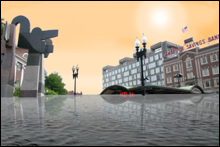Four years in the making and commissioned by the Environmental Protection Agency to the tune of almost $1 million, CLIMB was the first study of the effects of global warming on a metropolitan urban area. “When people started talking about climate change in the late ’80s, mid ’90s, they focused on things like agriculture, fisheries, water supply,” says Kirshen. “Everyone said you didn’t have to worry too much about the cities. But it turns out all the infrastructure that makes city life possible depends very much on climate. Buildings are designed for certain temperatures, so they need to be cooled and heated correctly. Water-supply systems are designed for so much ground-water availability. Health systems are very climate sensitive. Infrastructure is very sensitive to climate.”
Here in Boston, we have much more than heavy rains to worry about. By 2100, the metro-Boston area can expect a six-to-10-degree-Fahrenheit rise in average temperature, according to CLIMB’s findings. Sea levels could be as much as a meter higher; heavy rains like what we had in May would cause much more extensive flooding. The city’s 100-year-old sewer systems — which by then would be 200 years old — could make for big messes. In outlying areas, wetlands and estuaries could be damaged irrevocably. With more than 30 days a year exceeding 90 degrees, energy demands could skyrocket as more and more people tried to stay cool in the summer. There will be more air pollution. There will be more health problems, resulting from higher temperatures and from disease borne by exploding bug populations. Depending on the severity of the weather, the price tag for the havoc wrought on infrastructure and for emergency services could approach $100 billion.
Here’s how it may all wash out.
|

Harvard Square in 2106: submerged?
|
Storms: the New Orleans of the North
One hundred years from now, Massachusetts could look very different. The short animated films produced by CLIMB (watch them at net.org), showing the effect of a one-meter sea-level rise as the polar ice caps melt, are startling. In Boston, downtown and the waterfront look otherworldly, like some half-submerged Atlantis. The gorged Charles River swells and spills over into the Back Bay and Cambridge. On Martha’s Vineyard, the seas swallow Little Beach and Chappaquiddick, creeping inland toward Edgartown. When the effects of a Category 2 storm surge are factored in, the blue waters fill the screen.
“The rate of sea-level rise has doubled in the last 10 years,” says Ross Gelbspan, retired special-projects editor at the Globe and the author of The Heat Is On: The Climate Crisis, the Cover-up, the Prescription (Perseus) and Boiling Point: How Politicians, Big Oil and Coal, Journalists and Activists Are Fueling the Climate Crisis — And What We Can Do to Avert Disaster (Basic). Worse, were the city to be struck by a strong hurricane or a nor’easter, Gelbspan says, “all bets are off in terms of the ability of the Cape and the whole southeastern coastal Massachusetts to look very different than the way New Orleans looks now.”
ADVERTISEMENT
 |
Warmer, deeper waters mean worse storms. “Warm water doesn’t make for more hurricanes,” says Gelbspan, “but it makes for much stronger hurricanes.”
And in Boston — where, by 2050, 1.4 million people will live along the shore — the effects of severe flooding from a major storm would be extensive: damage to property, disrupted or paralyzed transportation, interrupted energy distribution, and impaired wastewater treatment. With a long coastline and countless inland waterways, the area would be extremely vulnerable to disastrous floods.
The climate: Boston meets Carolina
“The climate of North Carolina should be about what we expect in Boston around 2100,” says Matthias Ruth, a professor of environmental economics and policy at the University of Maryland, who contributed to CLIMB. “That’s a significant change.”
Yes it is. Gone would be the sub-zero deep freezes of traditional New England winters; in their stead would be moderate coolness. And no longer would we have balmy summer days, sunny and 70s, custom-made for lolling on the Common or sailing the placid Charles. Instead, the height of the season will be scorching, sweltering, hot-as-blazes torture. Even worse, as we try to stay cool, we’ll only exacerbate the problem.
A proliferation of air conditioning leads to what’s called “positive feedback”: more space-cooling gobbles up more electricity, which necessitates more electricity production, which creates more greenhouse gases, which lead to higher temperatures and more air conditioners. One key to breaking free of that vicious circle is a more holistic approach to changing temperatures. This would mean changing the way cities are planned and the way living spaces are built.
“Right now in Boston, houses are [often] like brick ovens,” says Ruth. “Red brick outside. Black tar roof on the top. Put sunlight on them all day long for a few days, and indoor-air temperatures get significantly higher.” We should build with materials that are less heat absorbent. We should plant trees for shading. Even better, we should make use of photovoltaic shingles, which absorb the heat but also provide energy to take care of our cooling needs.